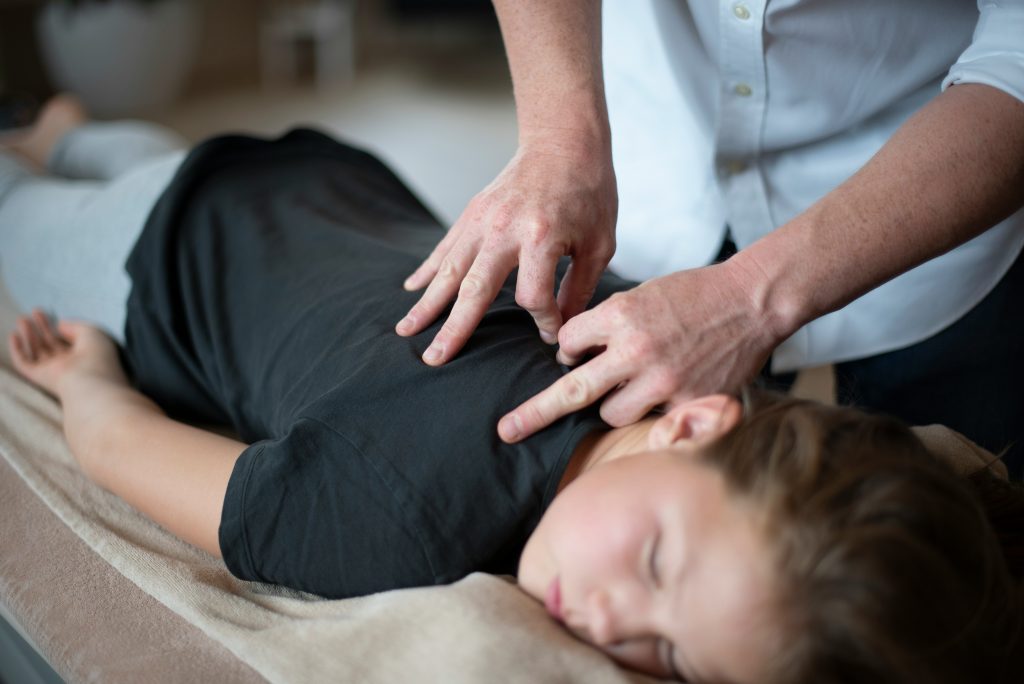Osteopathy
Osteopathy: treating the body as a whole
L'osteopathy is a recognised therapeutic approach focused on the health and overall well-being of the individual. It views the body as a functional unit in which each structure - muscles, joints, ligaments, viscera, nervous system - interacts with the others. When an imbalance occurs, it can manifest itself as pain, loss of mobility or various functional disorders.
Using precise, gentle techniques tailored to each patient, the osteopath releases tension and restores harmony between the body's different systems. Unlike some treatments, which are limited to relieving a symptom, osteopathy seeks to find a solution to the problem. root cause of the imbalance.
Areas of osteopathic action
Osteopathy can be indicated in many situations. It does not replace medicine classic, but complements it effectively. Among the most frequent reasons for consultation:
- Musculoskeletal pain These include low back pain, neck pain, back pain, torticollis, sciatica and pain linked to poor posture or repetitive strain.
- Joint problems stiffness, loss of mobility, after-effects of injury or trauma.
- Headaches and migraines often linked to cervical tension or poor posture.
- Functional digestive disorders bloating, constipation, gastro-oesophageal reflux.
- Supporting pregnant women relieves lower back pain, improves comfort and mobility.
- Paediatrics Follow-up of infants with congenital torticollis, plagiocephaly, reflux or colic.
- Sports Optimising recovery, preventing injury and improving performance.

Course of a session
An osteopathy session lasts an average of 45 minutes to an hour. It takes place in several stages:
- Case history The osteopath takes the time to listen to the patient and analyse their medical history and lifestyle.
- Clinical examination Osteopathy: through palpation, mobility tests and precise observations, the osteopath identifies areas of tension and restriction.
- Treatment He then uses a range of manual techniques adapted to each patient: gentle mobilisation, visceral, cranial and joint techniques.
- Personalised advice Recommendations for posture, lifestyle and simple exercises can be given to prolong the effects of the session.
The aim is to restore optimal mobility and allow the body to regain its natural self-regulatory capacity.
The benefits of osteopathy
Osteopathy is gentle and respectful of the body. In particular, it helps :
- relieve acute or chronic pain,
- reduce muscular tension,
- restore joint mobility,
- improve circulation and exchanges between tissues,
- reduce stress and promote relaxation,
- prevent the recurrence of certain disorders.
By improving overall balance, osteopathy contributes to a better quality of life and lasting well-being.

Why consult an osteopath at our medical centre?
At our medical centre, osteopathy is part of a comprehensive approach multidisciplinary. Our osteopaths work in collaboration with doctors, physiotherapists and other health practitioners to ensure comprehensive and consistent follow-up.
Every patient - adults, children, infants, pregnant women and the elderly - benefits from personalised care that takes account of their specific needs, age and state of health. Our aim is to provide practical, sustainable solutions, while always respecting the patient's safety and comfort.
An approach for everyone
Whether you suffer from recurring pain, functional disorders or are simply looking to improve your balance and well-being, osteopathy can help. It is aimed at :
- adultsoften affected by stress and a sedentary lifestyle,
- children and teenagersand growing,
- infantsto support their development,
- pregnant womento relieve the discomforts associated with pregnancy,
- seniorsto maintain mobility and independence.
In a nutshell
L'osteopathy is a discipline that focuses on the body's mobility and balance. It provides effective, natural and lasting solutions to relieve many functional disorders. At our medical centre, our osteopaths put their expertise and attentiveness at your service to help you regain comfort and well-being in your daily life.


